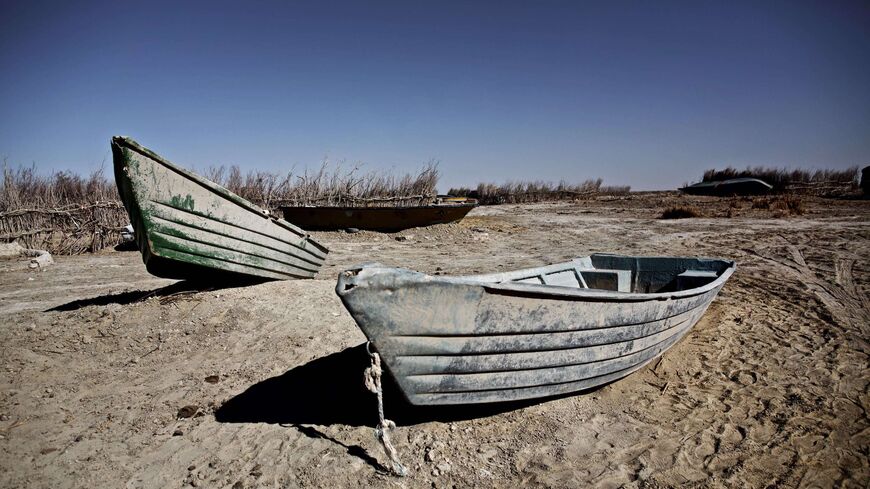Tensions have escalated between Tehran and the Taliban regime in Kabul over the distribution of their shared waters. As Iran faces increasing water scarcity issues, Afghanistan is trying to dam water sources as much as possible to generate electricity and irrigate agricultural land.
Originating in the Afghan Hindu Kush mountain range, the Helmand River is Afghanistan’s longest river that flows across the country before it winds down to the Iran border and runs into the Hamoun Lake that is accessible to both sides. For centuries, it has been a primary source of drinking water, fishing and irrigation for both countries. The Afghan-Iranian Helmand River Water Treaty of 1973 stipulates that Afghanistan must deliver water to Iran at an annual average of 820 cubic meters under normal conditions. While both parties signed onto this treaty, it was never ratified. Increasing the murkiness of the dispute, Article V of the document states that Afghanistan has complete ownership of the rest of the water supply.
The treaty’s terms and implementation are a gray area that has caused the festering Iran-Afghanistan water dispute.
In late May, two Iranian security personnel and one Taliban fighter were killed in a heavy exchange of gunfire at the border. Subsequently, the Iranian authorities closed the Milak-Zaranj border post, which is an important commercial crossing, until further notice.
Just weeks before this clash, Iranian President Ebrahim Raisi had warned the Taliban not to violate Iran’s water rights. Objecting over the construction of dams, Raisi suggested instead that the Taliban allow Iranian hydrologists to check water levels.
In response, Amir Khan Muttaqi, the Taliban’s foreign minister, had said that Iran should engage in “face-to-face talks instead of making noises.” Last year, Iranian Foreign Minister Hossein Amir-Abdollahian had discussed with Muttaqi Tehran’s rights over the Helmand River’s waters, but the Taliban continue to plan more dams.
Apparently, the situation has worsened after the opening in 2021 of Kamal Khan Dam in the Chahar Burjak district. While it improves Afghanistan’s water security, it has become an environmental concern for drought-ridden Iran. At its inauguration, then-President Ashraf Ghani said, “Afghanistan would no longer give free water to anyone, so Iran should provide fuel to Afghans in exchange for water.”
Hamidreza Azizi, a visiting fellow at the German Institute for International and Security Affairs (SWP) in Berlin, told Al-Monitor that the water crisis is not new, and precedes Taliban takeover in 2021. ”Considering the background, this water issue is not something from the past few years, it has always been part of Tehran’s problems with Kabul. This matter was already there before the Taliban, even with the Ashraf Ghani government. The main Iranian grievance is the lack of commitment on the Afghan side with regard to its share of water,” he said.
If not for these ongoing frictions, Iran-Taliban ties look promising.
Even though Tehran stopped short of recognizing the Taliban government in Kabul, it has been one of the few countries that maintained diplomatic relations and retained its embassy in the country. Meanwhile, the regime in Kabul showed interest in upgrading economic and security ties with Iran, and the Afghan Embassy in Tehran was formally handed over to the Taliban in February.
Millions of Afghans have fled conflict at home to find refuge in Iran. Since 2021, the number has only increased and around 600,000 Afghan passport holders are in Iran currently. In addition, as per 2022 data from the United Nations High Commissioner for Refugees, almost 2.1 million Afghans are undocumented.
Notwithstanding the convergences, cracks are apparent in the Afghan-Iranian equation due to the chronic water dispute. Even after a series of negotiations over the water issue between local Iranian and Afghan officials, this divergence remains unresolved.
“What has made this issue even more serious now is environmental changes that make access to water resources a security issue. Thus, the matter has become more securitized and has increased the threat level perception. In the case of Iran and Afghanistan, if you consider the aggressive, undiplomatic way the Taliban are handling the issue, the border tensions make more sense,” Azizi said.
Practically, the problem is unlikely to end if more major dam projects are constructed on the Afghan side to restrict the flow of water to the Sistan Basin while Iran’s worst-affected southeastern region keeps on getting drier. In the past, water scarcity has fueled farmers’ protests in Iran.
Escalation and implications for the region
Geneva-based Afghan analyst Torek Farhadi told Al-Monitor that both Iran and the Taliban don’t want to escalate the situation. “Iran has enough enemies in the region and beyond, and it knows it is not wise to open a war front with the Taliban in Afghanistan. The Taliban also want to give an image of peaceful Afghanistan as well as good neighbor; they will not get themselves involved in larger-scale military hostilities with Iran,” he said.
Describing the mood in Iran after the recent spat, Azizi assessed that both sides were trying to keep the issue under control. “Especially Tehran, even though public opinion is in favor of military action, be it large-scale or small-scale. Iranian policymakers would not go ahead as Iran is already overstretched in the Middle East toward its western borders and any military conflict on its eastern side can create an opportunity for adversaries, like Israel and other states, to take advantage. Due to these calculations, it may not turn into a big conflict in the short term,” he noted.
“Also given the huge number of refugees living in Iran, many of them may have sympathies and connections with the Taliban, and if any actual conflict happens they can act as a fifth column of the Taliban and create problems from within the country,” Azizi added.
In the meantime, the Afghan side of the border is becoming one of the country’s most productive agricultural areas and to top it all, Kabul has decided to build more dams.
“In Afghanistan, a number of southwestern provinces are irrigated by this flow and close to 11 million people are in need of water. Everyone knows that the entire South Asia region is walking into a water scarcity ticking bomb, but with good relations the water crisis can be managed with Iran,” Farhadi said.
In his opinion, the water crisis is manageable even though the Helmand River treaty was signed under the late King Zahir Shah 50 years ago and “it satisfies the situation.” Instead, Farhadi feels that Iran has not managed its water resources well and it “owes better service delivery to its population in Sistan-Baluchistan.”
“In Iran, water from Afghanistan is a necessity but water itself is a political matter where the regime has logged several years of water management shortcomings,” he noted.
Keeping Beijing’s current peacemaking role among its close allies in mind, Farhadi also highlighted the broader implications for the region. “Last but not the least, this entire region is increasingly becoming China’s zone of influence and it has sway over both Iran and Afghanistan. It will ask both countries to tone down this conflict and get along,” he added.
Since the passage of the Helmand River treaty did not lead to a peaceful resolution, the two sides need to find ways to settle the issue that take into consideration the growing challenge posed by climate change and the resulting drought. Joint hydrometric stations were suggested to improve the system and an agreement was reached during the 21st meeting of the Joint Committee of Commissioners of the Helmand River in November 2019. A timeline was agreed upon to construct the stations, but it was never implemented.
Since the uncertainty continues, Azizi did not exclude the possibility of more clashes. “A lot depends on how the Taliban handle this issue. It may finally result in military confrontation but given the need for political will, the overall assessment is that it will not happen unless provocations happen again,” he concluded.








